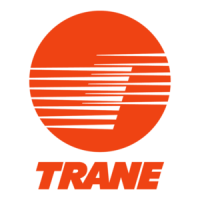Operating Procedures
ARTC-SVX005A-EN 47
11. Verify that pressure switches and thermostats have the
correct cut-in and cut-out settings using the
touchscreen interface panel.
Emergency Power Shutdown
The chiller does not include a disconnect to turn off the
high voltage to the modules. As per NFPA 70, The National
Electrical Code, a disconnect must be installed within the
line of sight of the electrical and control panel. Should an
emergency condition arise, the disconnect must be
opened to shut down all voltage to the chiller/heater.
There are several ways to interrupt power to all or part of
the chiller/heater:
• Disconnect the primary power source from the
building that feeds electricity to the chiller/heater.
This occurs in sudden emergencies (usually
weather-related) or planned maintenance shut-
downs.
• Press the panel disconnect switch on the exterior
door of the chiller/heater’s main power distribution
panel, if so equipped.
• Move the circuit breaker switch to the OFF position
(CB-1 and CB-2) on the power distribution panel.
This cuts power to all of the chiller/heater modules.
• Move the circuit breaker switch to the OFF position
(CB-1 and CB-2) on a module’s electrical and control
panel. This cuts power to the compressors in a
single module. It does not cut power to electrical
and control panel or other chiller/heater modules.
• Press the SYSTEM ON button on the touchscreen
interface panel that is built into the power
distribution panel door.
Note: Pressing the SYSTEM ON button on the
touchscreen interface panel does not de-energize
the chiller or the high voltage current into each
module’s electrical and control panel. This action
sends a command to the controller in each
module’s compressors to discontinue electrical
current to that component.
Water Quality Guidelines
The chiller is equipped with high efficiency compact
brazed plate heat exchangers (BPHX). Water quality must
be maintained periodically by the end user to avoid scaling
and corrosion inside the heat exchangers.
Monitor Water Quality
Maintaining water/glycol mixture quality and cleanliness
is critical to chiller/heater health and maintainability.
Strainers should be checked and cleaned on a regular
basis. Water/glycol mixture samples should be taken and
tested by a professional lab. The results will enable the
accurate adjustment of quality thereby increasing the
operational life of the chiller/heater.
Note: Trane will not validate the chiller warranty if the
proper water/glycol mixture composition and
quality is not maintained.
Protect the chiller/heater from freezing, particularly if the
chiller has a set point that is lower than the freezing point
of the water/glycol mixture in the chiller/heater. The chiller/
heater is designed to operate with a maximum propylene
glycol concentration of 50%. See Table 10, p. 48, for the
effects on the chiller when operating with other glycol
concentrations.
Table 10, p. 48 shows the capacity reduction and the
pressure drop that occurs when higher concentrations of
glycol are used.
Maintain Glycol Level
When the chiller has a water set point that is below the
freezing point of the water/glycol in use, take precautions
against freezing.
Table 9. Water quality guidelines
Element /Compound/
Property Value/Unit
pH 7.5 - 9.0
Conductivity < 500 μS/cm
Total Hardness 4.5 - 8.5 dH°
Free Chlorine < 1.0 ppm
Ammonia (NH
3
) < 0.5 ppm
Sulphate (SO
4
2-
) < 100 ppm
Hydrogen Carbonate (HCO
3-
) 60 – 200 ppm
(HCO
3-
) / (SO
4
2-
)> 1.5
(Ca + Mg) / (HCO
3-
)> 0.5
Chloride (Cl-) < 200 ppm
Notes:
1. Total Hardness/corrosion: Water with high hardness can cause
corrosion problems due to its high ion content (Ca+2, Mg+2, Fe+2)
which also means a high electrical conductivity and a high total
dissolved solid (TDS). For this reason, too high hardness values
should be avoided, not only due to higher risk of scaling, but also for
corrosion risk.
On the other hand, soft water, but not necessarily cation exchange
softened water, may in contrast have a low buffering capacity and so
be more corrosive. If the hardness values are outside the
recommended range, other parameters such as oxygen content,
conductivity, and pH values should be considered to evaluate the
corrosion risk.
2. Fe3+ and Mn4+ are strong oxidants and may increase the risk for
localized corrosion on stainless steels in combination with brazing
material copper.

